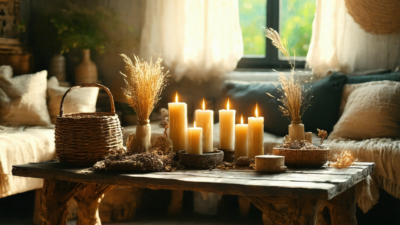Discover the Joy of Growing Fresh Herbs at Home
Are you tired of buying herbs from the store, only to have them wilt within days? With a mini herb garden right in your kitchen, you can enjoy fresh, aromatic herbs whenever you need them. It’s not just about convenience—it’s about enhancing your culinary experience and adding a touch of greenery to your living space.
Why Start a Mini Herb Garden?
Beyond the obvious benefit of having fresh herbs on hand, growing your own can be incredibly rewarding. It’s a great way to connect with nature, even in the confines of an urban apartment. Plus, it’s a fantastic introduction to gardening for those who might think they don’t have a green thumb.
Here are some reasons to give it a try:
- Ease of access: No more running to the store for that missing ingredient. Your herbs will be right there, ready to snip.
- Cost savings: Over time, buying fresh herbs can add up. Growing your own is a cost-effective solution.
- Health benefits: Fresh herbs are packed with nutrients and can elevate the flavor of meals without added salt or fat.
Selecting the Right Herbs for Your Mini Garden
Not all herbs thrive indoors, but there are plenty that do. Start with these popular choices:
- Basil: A must-have for any kitchen, especially if you love Italian cuisine.
- Parsley: Great as a garnish or in recipes like tabbouleh and pesto.
- Mint: Perfect for teas, cocktails, or adding a refreshing touch to desserts.
- Rosemary: Ideal for seasoning meats and roasted vegetables.
Consider the sunlight your kitchen receives when choosing herbs. For example, sage and thyme prefer bright light, while cilantro can tolerate lower light conditions.
Gathering Your Tools and Materials
To set up your mini herb garden, you’ll need:
- Pots or containers with drainage holes
- Quality potting soil (look for one labeled for herbs or vegetables)
- Herb seeds or small plants
- Fertilizer (optional, but beneficial for healthy growth)
- Watering can or spray bottle
Containers come in all shapes and sizes. Repurpose items like mugs, jars, or even old boots for a quirky touch! Just ensure they have proper drainage to prevent root rot.
Step-by-Step Guide to Setting Up Your Garden
- Choose the Right Spot: Most herbs need at least 6 hours of sunlight daily. A windowsill is usually ideal, but if your kitchen doesn’t get enough light, consider using grow lights.
- Prepare Your Containers: Fill each container with potting soil, leaving about an inch at the top for water to drain.
- Plant Your Herbs: Gently place your herb plants in the soil, ensuring they’re spaced properly. For seeds, follow the packet instructions regarding depth and spacing.
- Water Thoroughly: Water until you see it draining from the bottom holes. Avoid overwatering, as herbs prefer well-drained soil.
Maintaining Your Mini Herb Garden
Caring for your herb garden is straightforward with a few key tips:
- Water wisely: Let the soil dry slightly between waterings. Use a spray bottle to gently mist leaves, especially if your kitchen air is dry.
- Fertilize occasionally: Feed your herbs with a balanced fertilizer every few weeks during the growing season.
- Prune regularly: Pinch off the tips of stems to encourage bushier growth and prevent plants from becoming leggy.
- Harvest often: Snip leaves as needed, but don’t remove more than a third of the plant at once. This ensures healthy regrowth.
If you notice pests like aphids or spider mites, a gentle soap solution can help keep them at bay. Neem oil is another natural deterrent worth trying.
Enjoying the Fruits of Your Labor
Once your herbs are thriving, it’s time to start using them in your cooking! Here are some ideas:
- Add fresh basil to pasta dishes or make a homemade pesto.
- Sprinkle parsley over soups and salads for a vibrant finish.
- Infuse mint into teas, smoothies, or cocktails for a refreshing twist.
- Use rosemary to season meats or as a fragrant addition to bread recipes.
Drying herbs is another excellent way to preserve them. Simply tie bunches together and hang in a cool, dark place until crispy. Then store in jars for future use.
Common Mistakes to Avoid
Even experienced gardeners make mistakes, so don’t be discouraged if things don’t go perfectly at first. Here are some pitfalls to watch out for:
- Overwatering: This is one of the leading causes of plant death. Always check the soil before watering.
- Inadequate light: Without enough sunlight, plants will become leggy and weak. Rotate pots weekly to ensure even growth.
- Poor drainage: Standing water can lead to root rot. Make sure containers have proper drainage holes.
Final Thoughts
A mini herb garden is more than just a functional kitchen accessory—it’s a delightful way to bring nature indoors and add freshness to your meals. With minimal effort, you can enjoy the beauty and bounty of herbs all year round.
So why wait? Gather your supplies and get started today. Before long, you’ll be savoring the taste of homegrown herbs in every dish!
Bonus Tip:
If space is limited, consider vertical gardening solutions like hanging pots or wall-mounted planters to maximize your area.





